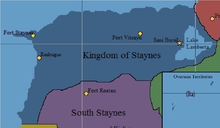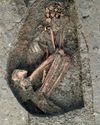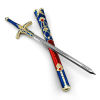Staynes
| This page is a work in progress by its author(s) and should not be considered final. |
| The United Nine Tribal Kingdoms of Staynes | ||||
|---|---|---|---|---|
|
||||
| Motto: In the depths of winter will you find sanative. | ||||
| Anthem: "Rise the Empire through Union" | ||||
| Capital and largest city | Sani Bursil | |||
| Official languages | (By first language) Staynish (Simplified) 60.7% |
|||
| Ethnic groups (2016) | 99.9% Human | |||
| Demonym | Staynes, Staynish, Staynic (rare) | |||
| Government | Kingdom | |||
| - | High-King | Lambertus VII Constantine | ||
| - | Prince | Thadeus Galfridius Constantine | ||
| Legislature | National assembly | |||
| - | Upper house | Hikleme (House of Royals) | ||
| - | Lower house | Vikeoa (Peasants House) | ||
| Area | ||||
| - | Total | (n/a) km2 (n/a) sq mi |
||
| Population | ||||
| - | 2016 estimate | 147,653,120 | ||
| - | 2012 census | 142,442,302 | ||
| - | Density | (n/a)/km2 (n/a)/sq mi |
||
| GDP (nominal) | 2016 estimate | |||
| - | Total | S♅6,137,708,383,001.6 | ||
| - | Per capita | S♅43,089.08 | ||
| Gini (2014) | 26.3 low |
|||
| HDI ((n/a)) | 0.8 high |
|||
| Currency | Staynish Kirib (S♅) |
|||
| Date format | DD/MM/YYYY | |||
| Drives on the | the left | |||
| ISO 3166 code | STA | |||
| Internet TLD | .sta | |||
The United Nine Tribal Kingdoms of Staynes, or more commonly referred to as Staynes, is a large nation that resides on the northern coast of the Auroran continent. The mainland borders with Axdel, South Staynes, Ethalria & Caltharus, whilst Staynish Justelvard borders with Berica, Staynish Horales borders with Spoontuis and Staynish Joralesia borders with Switzerland and Setzna. Staynes, which is densely populated in the cities and far less in the countryside, has an estimated population of 147,653,120 people with a GDP per capita of S♅43,089.08, whilst Joralesia around 20,430,200 people, Justelvard around 12,100,530 people, Horales estimates at 5,800,756 people and the remainder islands a population of around 400,000.
One of the oldest standing nations in Aurora, Staynes was originally called Morstaybishlia for over a thousand years. It has been Monarch run since the first King of Morstaybishlia, King Pip Makuh, 1132 years ago. The Empire took complete control over Joralesia in the War of Joralesia 1716 - 1755 after a long bitter war with the inhabitants. Following The Auroran Imperial War, the Morstaybishlian Empire broke down, and was reclassified as the Staynish-Caltharus Empire, where Staynes has existed since the 11th of May 1970.
Contents
Armed Forces
The Royal Staynish Armed Forces has been the Armed Forces unit of Staynes and Morstaybishlia throughout its history. It has seen many battles and wars in its 1062 years in existence, such as the Stand of Fifty, the battle led by King Pip that established the Armed Forces, and other examples such as the Battle for Caltharus 1515, the War of Joralesia 1716 - 1755, and most recently, The Auroran Imperial War. The Royal Staynish Armed Forces is centred in Xenliada, a military fortress which is two thirds the size of Redrugus; the city that it lies next to, which is the second largest city in Staynes. There is three branches of the Royal Staynish Armed Forces:
(WIP)
Government
(WIP)
Kirib
The Kirib is a multi-continental influential currency which spans across The East Pacific. The Kirib has origins dating back to King Gustav I, and historical documentation of the first phase Kirib in 1422 (1 year after the death of his father), originally referred to as the Morstaybishlian Kiribin, and shortened by Gustav I to the Morstaybishlian Kirib in 1429. It was later changed to the Kirib around 1893, following its influence in several nations, and changed into branches of the Kirib according to which nation you were from on the 30th July 1975, following the end of The Auroran Imperial War.
There's been many nations that have used the Kirib. The current holders of the Kirib are:
- Staynes
- South Staynes
- Axdel
- Caltharus
- Spoontuis
- Staynish Joralesia
- Staynish Horales
- Staynish Justelvard
History
Ancient Maltervenia
Ancient Maltervenia symbolises the time period from where the native inhabitants began to utilise the land around them until their tribal formations around 3000 years ago. It is not certain the exact time period that people began living in the lands of North Aurora and modern Staynes, but it is believed to be as much as 7000 years ago. The best estimate of the size of the Maltervenian population around 5000 years ago is placed around 14,100, with other top archaeological, science and research sources estimations reading as little as 3,000 and as much as 75,000. Based on proof that this were the time of major Auroran Volcanic activity, such numbers are quite impossible to fathom.
Ancient Maltervenians from 7000 to 4000 years ago had a tendency of living on their own, playing the role of hunter gatherers. Sources suggest that these people eventually understood the capabilities of working in units and in 1976 the first evidence of this was found as cave art, dating back to 4000 years ago. Beyond this point in time, Maltervenians gained the upper hand and instead of being labelled as prey, they had become the predator. It is clear from petrified samples after this point that these people lived sporadically around the nation in wooden and stone huts, preferring the plains and deciduous forests to the rough inclinations of the Mountain range and the dense northern jungles.
It became common for Maltervenians to wear the dried skins of the toughest animal they slew. This represented power and strength as a warning to others or as a gesture of protection whilst searching for a mate. In more southern areas, it was common that Maltervenians wore bones on their animal skins to pronounce themselves especially whilst searching for a mate. These factors lead to females to choose the male with the most feared animal skins and or most feared animal tusks, skulls, ribs or fingers, resulting in the strongest males producing offspring and the weakest dying off. It varied from area to area, but commonly these people were buried without their possessions, as myths of the undead returning with great deals of power resulted in their possessions being burnt.
It was around 3000 years ago that these people came to form tribes, as the population grew extensively and people began living amongst themselves.
Tribal Times
Ancient Morstaybishlia
Ancient Morstaybishlia marks the period of time between 925 and 1515, from the very first King of Morstaybishlia, Pip Makuh, to Lambertus III. Within this time period, the nation unified from the first Morstaybishlian tribe; Jubliak, to every tribe within the modern borders of Staynes and South Staynes (roughly 18). The nation held a dear 29 monarchs, all which has their own documented history.
Morstaybishlian Empire
The Morstaybishlian Empire was a large Empire founded in 1515 after King Lambertus III of Staynes reclaimed the Caltharus throne, and later his grandson, King Redrugus IX, annexed Kormistazm as a Principality of the Empire. The Empire spanned the majority of the Auroran continent, which consisted of Staynes (Staynes and South Staynes), Caltharus and Kormistazm, before it became known as Norograd during the last century, which itself consists of modern day Emberwood Coast and Quartz Fern Coast, before its demise in 1970.
Auroran Imperial War Involvement
Staynish-Caltharus Empire
State of Morstaybishlia
In August 2003, a militant resistant group seized control of Fort Staynes after uproar surged from the City Mayor election, which resulted in the Kings psychotic fourth cousin, Yarro Vondeler Peekio being elected. The self-declared State of Morstaybishlia lasted for 2 years, and was named after the previous country, Morstaybishlia. The reasoning behind the States survival came down to Royal blood hostages, including the Kings mother. Their leadership changed 4 times, from Abjazl Lecrane, Herdio Washik, Georgio Vermana and finally Zercrod Furista the Hated. In September 2005, a classified Special Operations team infiltrated the State using deception and false IDs and retrieved the royals. The States people, seeing their opportunity to take back their city, did so and the State fell back into the hands of Staynes. Throughout the existence of this State, the Royal Staynish Armed Forces closed all trade routes surrounding the micro nation in an attempt to choke the nation of resources. This succeeded to some stature until Zecrod Furista threatened to kill the royal hostages. It is widely believed that Zercrod Furista went into exile somewhere in Yasteria, the exact whereabouts is unknown.
Monarchy
The Staynish Monarchy has existed since its creation in 972 by King Pip Makuh. The Monarchy has had major influence over Aurora, containing 34 Kings and 12 Queens. The current Monarch is Lambertus VII Constantine, who rules with the title 'High-King', derived from King Lambertus III The Great after successfully claiming the Caltharusian throne in 1515.
The Monarchy is represented by several iconic symbols. The most well known is Prince Gustav's (Previous heir to the throne, great grandchild of King Von) Dwarven Hellfire blade known as Archiden the Slayer, which was forged from the Great Hellfire of 712, which is used in the Royal Staynish Armed Forces badge ever since its formation and currently under high protection in the Sani Bursil Royal Palace. Another icon of the Monarchy is its Golden Rose (or in the Armed Forces; the colour of Stone which represents solidarity), which had its introduction on the first Staynish flag under the Monarchy and has been used ever since as a symbol of faith, power and leadership.
See article: List of Staynish Monarchs







